Snowflake Photography
I have been attempting to photograph snowflakes this winter, with the result that it has only snowed a couple of times since I began my efforts. However, in this endeavour, I have learned something very interesting. I knew that a digital camera made life much easier than the film 35mm I once owned. I knew in theory that the 35mm was easier than the cameras which had come a generation before me (note I do not say better, as that is arguable). I have learned that in a century, we have come from big, bulky microscope rig to something I can hold in my hand and easily move for just the right shot.
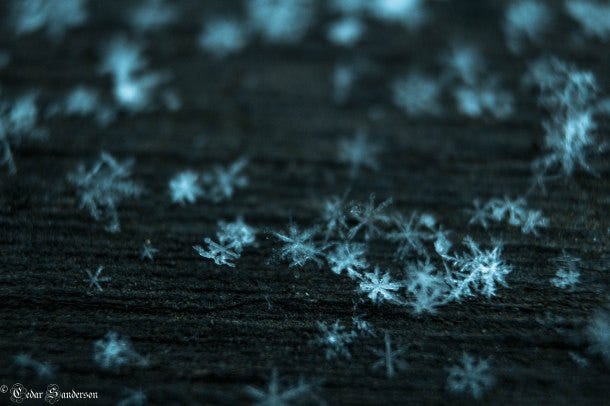
Snowflakes
My friend Brian suggested I look up Snowflake Bentley, when I posted a picture of a snowflake, and curious as always, I did so. The Vermont photographer was known a hundred years ago for his wonderful pictures of individual snowflakes. You can find a gallery of them here. I also discovered a link to his snowflake photography technique, published in 1922 back when Popular Mechanics was a magazine you could learn things from, much like the Maker movement in current days. I immediately began to appreciate my methods much more.
The apparatus required for snowflake photography consists of a compound microscope, fitted with a joint that permits the instrument to be turned down horizontally, at right angles to its base, so that it can be coupled to a camera bellows by means of a light-tight connection. The microscope objectives are used alone, without the eyepiece. It is best to have several different objectives; 1/2, 3/4, and 3-in. combinations, which give magnifications of from 8 to 60 diameters (64 to 3,600 times), will serve well.
Ordinary daylight, coming through a window, is used for illuminating the crystal after it has been placed on a microscope slide, a tiny beam of light entering through the small aperture in the substage of the instrument. The apparatus is placed indoors, near by and facing a window. The room, the apparatus, and its accessories should always be away from any source of artificial heat, and at a temperature approximately that of the outside air. The necessary accessories are an observation microscope, a pair of thick mittens, microscope slides, a sharp-pointed wooden splint, a feather, and a turkey wing or similar duster; also, an extra focusing back for the camera, containing clear glass instead of the usual ground glass, with a magnifying lens attached; this is used for final focusing. A blackboard, about 1 ft. square, with stiff wire or metal handles at the ends, so that the hands will not touch and warm it, is used to collect the specimens. As it is necessary to cover the end of the microscope objective with a strip of black card, that takes the place of the usual camera shutter which controls the duration of exposure, it is necessary to fit two vertical rods at each side of the microscope tube to hold the card. Prior to my decision to invest in a DSLR and the whimsy that led me to buy the lens extenders I'm using for snowflakes, I had come across another snowflake photographer who uses a hack which is quite ingenious to capture the delicate and unique crystals on the balcony of his Moscow apartment. As you will see, his images are night-and-day to the Snowflake Bentley shots, and a lot of this is the processing with computer rather than exposure of negatives. Alexey Klajatov is gifted and persistent, from the looks of his rig. I found it fascinating when I first ran across it a couple of years ago, but lacked the ability to do anything with it then.
Now, I have the Canon Rebel T5, although if I had to do it again I'd price the T5i which would allow me to use a true remote. But I bought this when it was on a serious sale, so there's that. I also picked up a set of lens extenders, which is how I am doing macro. I have learned that for the more lengthy extenders (28mm) I really need a tripod, but that with the 7mm or 14mm I can do hand-held for the snowflakes. The lens extenders I bought do not have the electical contacts that allow for auto-focus, adding another challenge to making sure your tiny DOF (depth of field) is in focus on the right flake. These do reduce the DOF to paper thin, which is why my One snowflake isn't all in focus, I was using the 7mm and 14mm stacked for that shot. But on the other hand, they make snowflake photography much easier than it was back in the day, and I'm looking forward to playing with post-processing if it snows again soon...
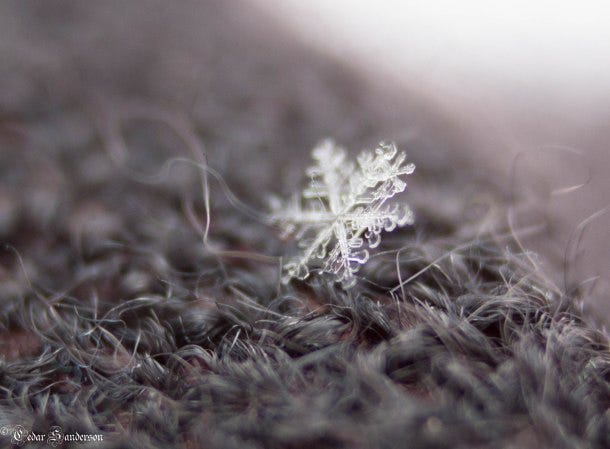
One
One was shot on a black scarf, which makes a nice contrast for the flakes, and let me capture individuals. As you will see with the other shot, Snow, trying to get an individual flake in a blanket of fallen snow is tricky. In addition to isolating one white on other whites, the flakes break under the weight of their surroundings. So the scarf, or shooting just as the snow begins to fall (tricky if it's still close to freezing) works best.
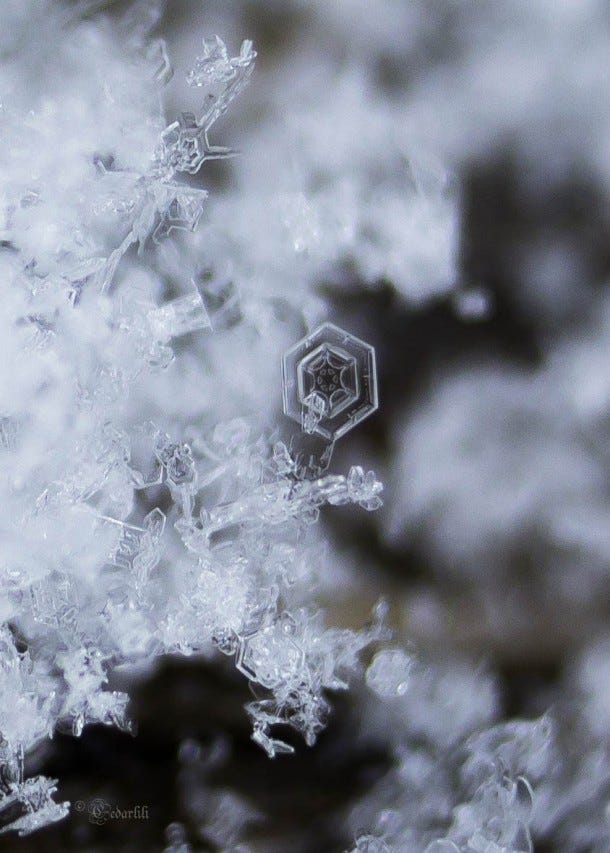
Snow: Standing out in the Crowd
And of course, as much as the equipment may have improved, you will still be outside in the cold, nothing you can do about that! Not all snow is going to look good under magnification, much depends on the temperature, and the colder the better in general. Warm air may melt the snowflake as it's falling. Too cold, and the flake may sublimate back into the air before you can get a good focus. I was finding that my breath was melting flakes while I got them into focus during the first shoot, as it was fairly warm (for snow! I think it was high twenties F that day).
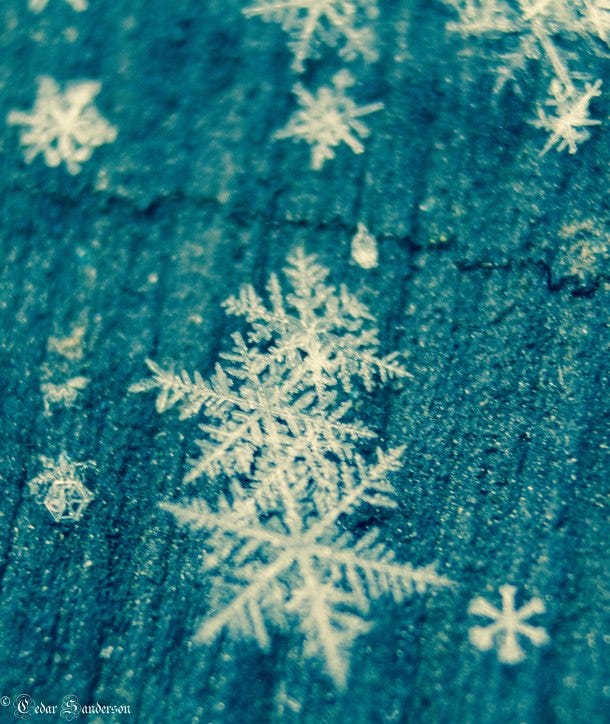
Like fallen stars, each crystal is different, and so beautiful when you consider they simply form like this out of thin air.
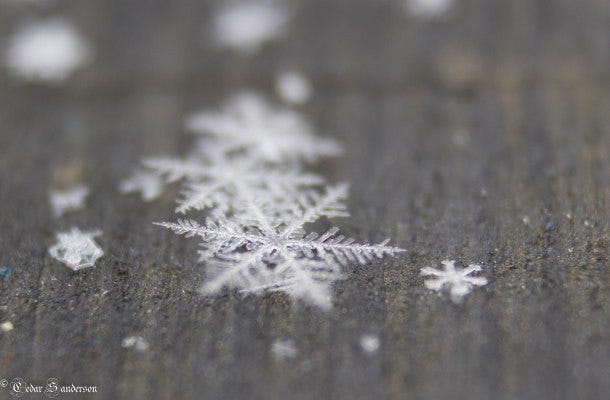
Snowflakes with a point




